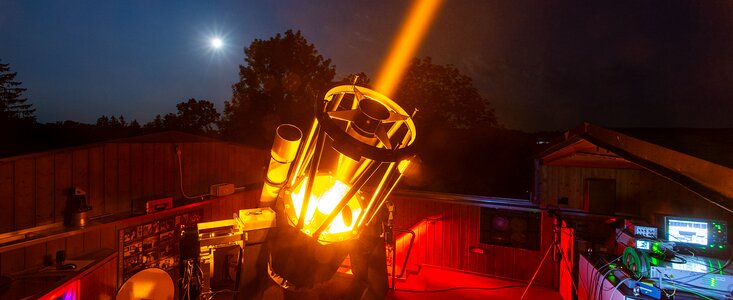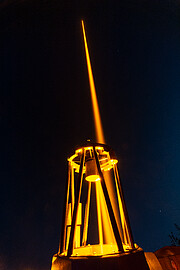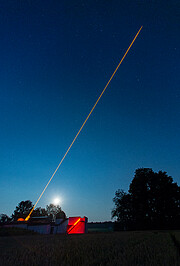Announcement
New powerful laser based on ESO technology passes field test
31 August 2021
A powerful experimental laser, based on ESO technology, passed a key test last month at the Allgäuer VolksSternwarte Ottobeuren observatory in Germany. The adaptive-optics laser, developed in collaboration with industry, has important additional capabilities compared to existing systems. It will be part of the CaNaPy Laser Guide Star Adaptive Optics system set to be installed at the European Space Agency’s (ESA) Optical Ground Station in Tenerife, Spain, in the frame of the ESO–ESA Research & Development collaboration. The higher laser power, nearly three times higher than in current systems, opens the door for developments in laser satellite communication, as well as significant improvements in the sharpness of astronomical images taken with ground-based telescopes.
Astronomical adaptive optics refers to systems on ground-based telescopes that correct for the blurring effect brought about by turbulence in the Earth’s atmosphere — the same effect that causes stars seen from Earth to “twinkle”. To remove the distortions, these systems require a bright reference star close to the object of study. Because these stars are not always conveniently placed on the sky, astronomers use lasers to excite sodium atoms at 90 km altitude in the Earth's atmosphere, creating artificial stars near the field of interest that can be used to map and correct the atmospheric turbulence.
The new experimental laser is based on the same ESO technology that is behind the Four Laser Guide Star Facility, successfully operating at ESO’s Very Large Telescope in Chile, as well as at most large astronomical observatories in the world. But while those lasers have a power of 22 Watts, this new laser has almost tripled the power at 63 Watts, a huge leap forward in astronomy laser technology that will, among other things, improve the sharpness of adaptive-optics images at visible wavelengths. As part of a collaborative R&D agreement with ESO, the Canadian company MPB Communications — one of ESO’s industry partners — has been able to scale up the power of their infrared “Raman fibre amplifier” source. This is the breakthrough that allows the ESO CaNaPy laser to achieve such a high power [1].
In addition, the German company TOPTICA Photonics AG, another of ESO’s industry partners, has developed and implemented in the CaNaPy laser a frequency chirping system for this new class of lasers, as part of a collaborative R&D agreement with ESO. Chirping consists in rapidly changing the frequency to which the laser is tuned. This increases the number of sodium atoms excited by the laser, making the artificial star brighter and thus improving the turbulence correction. TOPTICA has installed the chirping prototype on the 63 Watts laser and, with ESO, has commissioned on sky both the laser and its novel chirping system.
This new experimental CaNaPy laser is an example of astronomical technology developed in-house at ESO, in partnership with industry, and then transferred back to industrial usage including in new fields, thus finding applications beyond its original purpose and benefitting society as a whole. Once the CaNaPy facility instrument is installed at the ESA Optical Ground Station in Tenerife — a collaborative project between ESO [2] and ESA — it will provide both organisations, ESA and ESO, with opportunities to advance the use of laser guide star adaptive optics technologies not only for astronomy but also for satellite optical communication. Optical laser communication allows satellites to send and receive signals to and from Earth with ultra-fast bandwidth, a prospect that ESA is investigating. Optical laser signals can transmit much more information than radio signals, but they are equally affected by atmospheric turbulence. Laser guide star adaptive optics has thus the potential to greatly improve the optical links between satellites and ground stations.
Notes
[1] MPB Communications scaled up the power of their Raman fibre amplifier, which operates in the infrared at 1178 nm, from the 36 Watts level normally used in the commercial sodium guidestar lasers, to an unprecedented level of 100 Watts. This allows CaNaPy to achieve a continuous-wave power of 63 Watts while operating at 589 nm, in the visible.
[2] The collaboration includes several institutes in ESO member states: the Istituto Nazionale di Astrofisica in Italy, Durham University in the UK, and the Instituto de Astrofísica de Canarias in Spain.
Links
- Messenger article on Laser Development for Sodium Laser Guide Stars at ESO
- ESA Hydron Project
- Allgäuer VolksSternwarte Ottobeuren
- MPB Communications
- TOPTICA Photonics AG
Contacts
Domenico Bonaccini Calia
Physicist in the Laser and Photonics Group at ESO
Garching bei München, Germany
Email: dbonacci@eso.org
Juan Carlos Muñoz Mateos
ESO Media Officer
Garching bei München, Germany
Email: jmunoz@eso.org
About the Announcement
| Id: | ann21011 |
Our use of Cookies
We use cookies that are essential for accessing our websites and using our services. We also use cookies to analyse, measure and improve our websites’ performance, to enable content sharing via social media and to display media content hosted on third-party platforms.
ESO Cookies Policy
The European Organisation for Astronomical Research in the Southern Hemisphere (ESO) is the pre-eminent intergovernmental science and technology organisation in astronomy. It carries out an ambitious programme focused on the design, construction and operation of powerful ground-based observing facilities for astronomy.
This Cookies Policy is intended to provide clarity by outlining the cookies used on the ESO public websites, their functions, the options you have for controlling them, and the ways you can contact us for additional details.
What are cookies?
Cookies are small pieces of data stored on your device by websites you visit. They serve various purposes, such as remembering login credentials and preferences and enhance your browsing experience.
Categories of cookies we use
Essential cookies (always active): These cookies are strictly necessary for the proper functioning of our website. Without these cookies, the website cannot operate correctly, and certain services, such as logging in or accessing secure areas, may not be available; because they are essential for the website’s operation, they cannot be disabled.
Functional Cookies: These cookies enhance your browsing experience by enabling additional features and personalization, such as remembering your preferences and settings. While not strictly necessary for the website to function, they improve usability and convenience; these cookies are only placed if you provide your consent.
Analytics cookies: These cookies collect information about how visitors interact with our website, such as which pages are visited most often and how users navigate the site. This data helps us improve website performance, optimize content, and enhance the user experience; these cookies are only placed if you provide your consent. We use the following analytics cookies.
Matomo Cookies:
This website uses Matomo (formerly Piwik), an open source software which enables the statistical analysis of website visits. Matomo uses cookies (text files) which are saved on your computer and which allow us to analyze how you use our website. The website user information generated by the cookies will only be saved on the servers of our IT Department. We use this information to analyze www.eso.org visits and to prepare reports on website activities. These data will not be disclosed to third parties.
On behalf of ESO, Matomo will use this information for the purpose of evaluating your use of the website, compiling reports on website activity and providing other services relating to website activity and internet usage.
Matomo cookies settings:
Additional Third-party cookies on ESO websites: some of our pages display content from external providers, e.g. YouTube.
Such third-party services are outside of ESO control and may, at any time, change their terms of service, use of cookies, etc.
YouTube: Some videos on the ESO website are embedded from ESO’s official YouTube channel. We have enabled YouTube’s privacy-enhanced mode, meaning that no cookies are set unless the user actively clicks on the video to play it. Additionally, in this mode, YouTube does not store any personally identifiable cookie data for embedded video playbacks. For more details, please refer to YouTube’s embedding videos information page.
Cookies can also be classified based on the following elements.
Regarding the domain, there are:
- First-party cookies, set by the website you are currently visiting. They are stored by the same domain that you are browsing and are used to enhance your experience on that site;
- Third-party cookies, set by a domain other than the one you are currently visiting.
As for their duration, cookies can be:
- Browser-session cookies, which are deleted when the user closes the browser;
- Stored cookies, which stay on the user's device for a predetermined period of time.
How to manage cookies
Cookie settings: You can modify your cookie choices for the ESO webpages at any time by clicking on the link Cookie settings at the bottom of any page.
In your browser: If you wish to delete cookies or instruct your browser to delete or block cookies by default, please visit the help pages of your browser:
Please be aware that if you delete or decline cookies, certain functionalities of our website may be not be available and your browsing experience may be affected.
You can set most browsers to prevent any cookies being placed on your device, but you may then have to manually adjust some preferences every time you visit a site/page. And some services and functionalities may not work properly at all (e.g. profile logging-in, shop check out).
Updates to the ESO Cookies Policy
The ESO Cookies Policy may be subject to future updates, which will be made available on this page.
Additional information
For any queries related to cookies, please contact: pdprATesoDOTorg.
As ESO public webpages are managed by our Department of Communication, your questions will be dealt with the support of the said Department.



